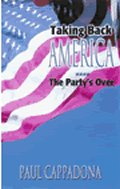HOW AND WHY THE FEDERAL GOVERNMENT CREATED THE MORTGAGE MELTDOWN
By Stan J. Liebowitz
October
10, 2008
NewsWithViews.com
We are experiencing one of the worst financial upheavals of the post-WWII era, driven primarily by a vast increase in the number of mortgage defaults. But why did the mortgage market meltdown so badly? Why were there so many defaults when the economy was not particularly weak? And why weren’t the securities based upon these mortgages considered anywhere as risky as they actually turned out to be?
In his new Independent Policy Report, Anatomy of a Train Wreck: Causes of the Mortgage Meltdown (The Independent Institute / October 3, 2008), Research Fellow and economist Stan J. Liebowitz reveals that the federal government has led a misguided attack on underwriting standards for more than a decade in a politically-motivated attempt to increase homeownership, particularly for minorities and the less affluent.
Homeownership had been stagnant in the U.S. for some time, Liebowitz says. Though seemingly noble for the government to want to stimulate new ownership, “the tool chosen to achieve this goal was one that endangered the entire mortgage enterprise: intentional weakening of the traditional mortgage lending standards,” he continues.
The government’s weakened underwriting standards allowed lenders to grant mortgages with virtually no down payments, few restrictions on the size of monthly payments relative to income, little examination of credit scores or employment history, and so forth. Initially these new rules succeeded in increasing home ownership rates, and “the decline in mortgage underwriting standards was universally praised as an ‘innovation’ in mortgage lending,” Liebowitz says.
As home ownership appeared to become easier, consumer demand spiked, resulting in a pricing boom at the turn of the 21st century. The rising prices ushered in a host of speculators, who accounted for roughly a quarter of sales during this time.
The speculators would buy and subsequently sell houses over short periods of time in the expectation of turning a profit, and of course the new loan standards appealed to them. They pursued adjustable rate mortgages with the smallest down payments and the lowest interest rates in order to secure the biggest return. It never mattered how painful these mortgages might become years down the road, because the home would be sold again long before then. As borrowers began to default on their loans, though, the high housing prices began to decrease. When the speculators realized they could no longer make a profit, they naturally left the market, leaving the investors who backed them with the mortgage debt. Liebowitz argues that this hypothesis—rather than the popular subprime vulture hypothesis—fits much better with the fact that foreclosures increased mainly for adjustable rate mortgages and not fixed rate, regardless of whether mortgages were prime or subprime.
It is necessary to understand what caused the mortgage crisis in order to avoid repeating history. Many pin the blame for the crisis on greedy and manipulative lenders or the speculators who bet on the basis of artificially inflated prices. However, in Anatomy of Train Wreck, Liebowitz argues that the government-dominated housing and regulatory establishment is truly at fault. Powerful government agencies and intellectuals must understand the imperative need for strict underwriting standards. Such standards are essential safeguards that ensure that housing prices accurately reflect supply and demand in the housing industry, preventing a housing bubble like the one that led to the current crisis, Liebowitz concludes. Lawmakers and government housing officials would do well to understand this, and they just might manage to avoid such a train wreck in the future.
|
Subscribe to the NewsWithViews Daily News Alerts! |
Anatomy of a Train Wreck is included in the forthcoming Independent Institute book, Housing America: Building Out of a Crisis, edited by Randall G. Holcombe and Benjamin Powell.
� 2008 - Stan J. Liebowitz - All Rights Reserved












